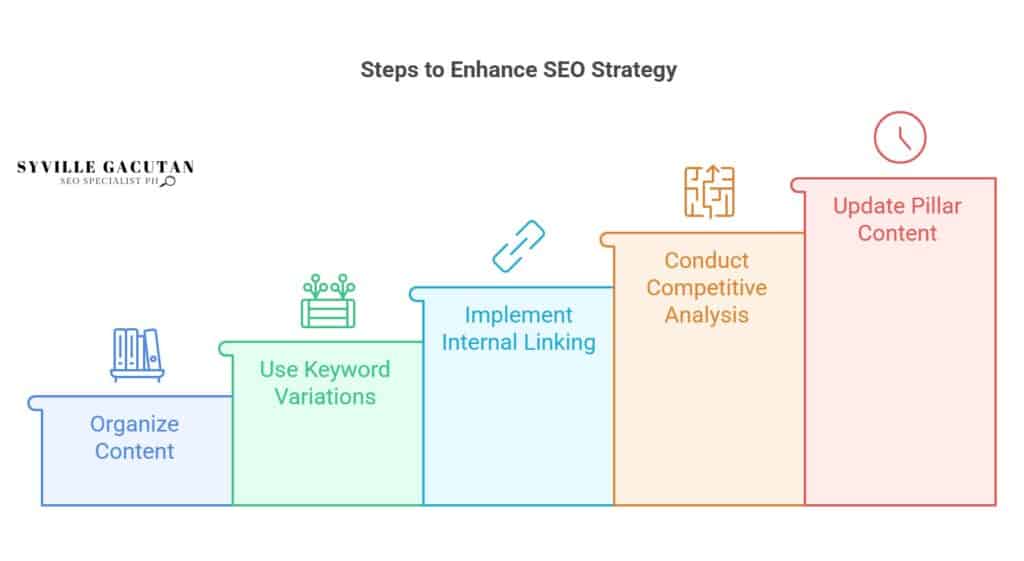
Boosting SEO With Strategic Topic Cluster Planning
Strategic topic cluster planning transforms SEO by building a well-organized content structure focused on key themes. This involves creating detailed pillar pages and linking them to cluster pages that dive into related subtopics. This clear organization enhances search engine indexing and keeps users engaged by showcasing how the content is interconnected. By predicting user intent and incorporating a range of keywords, businesses can extend their reach and address a wider variety of queries. This method not only boosts website authority but also helps identify opportunities through competitive analysis and content gap discovery. Delving deeper into topic cluster optimization for SEO can reveal powerful insights and innovative content management strategies.
Key Takeaways
- Organize content around core topics: Structure your content into main topics and link related subtopics to boost search engine recognition and improve visibility.
- Use keyword variations in topic clusters: Include different keyword variations within your clusters to capture a wider range of search queries and enhance SEO performance.
- Implement internal linking strategies: Create strong internal links to help users navigate your site easily and reinforce the thematic connections within your content clusters.
- Conduct competitive analysis: Identify gaps in your competitors’ content and uncover new opportunities to introduce fresh, innovative approaches in your industry.
- Regularly update pillar content: Keep your core content up to date for relevance, accuracy, and trustworthiness, boosting your site’s authority and improving SEO.

Understanding Topic Clusters
In the world of making websites rank higher on search engines like Google, understanding topic clusters is very important for creating a strong content strategy that matches how people use the internet today. A topic cluster is a way of organizing content around a main topic, making the content more relevant and covering the topic thoroughly. This approach not only makes the content more in-depth but also matches how people search for information by addressing different aspects of a subject.
A well-structured topic cluster revolves around a “pillar page,” which serves as the comprehensive resource for the main topic. Supporting this are “cluster pages,” which delve into subtopics and are interlinked with the pillar page. This interconnected structure aids search engines in recognizing the relationship between pages, thereby improving the visibility of the entire cluster in search results.
Central to the effectiveness of topic clusters is understanding user intent. By anticipating and addressing the queries users might have about a topic, content creators can tailor their material to meet diverse informational needs. This approach not only satisfies user intent but also encourages longer engagement and reduces bounce rates.
Furthermore, incorporating keyword variations within cluster pages ensures that content aligns with a broader range of search queries, capturing different aspects of user interest. As search trends evolve, leveraging keyword variations allows content to remain relevant and accessible, adapting to changing algorithms and user behaviors.
Benefits of Topic Clusters

Building upon the understanding of topic clusters, their implementation offers significant advantages that can amplify a brand’s online presence and effectiveness. Central to this is the enhancement of content organization. By structuring content around core topics and interlinking related subtopics, brands create a cohesive narrative that is both intuitive for users and search engines.
This meticulous organization not only aids in better indexing by search engines but also supports a clearer, more navigable user experience.
User engagement is another critical benefit derived from topic clusters. When content is strategically linked, users are more likely to explore multiple pieces of content, increasing time spent on the site and reducing bounce rates.
This seamless journey through interconnected content keeps users engaged, fostering a deeper connection with the brand while also boosting metrics that search engines consider when assessing site quality.
In terms of SEO performance, topic clusters enable a robust keyword strategy. By targeting a broader range of related keywords, brands can enhance their visibility across numerous search queries.
This approach allows for a comprehensive capture of search intent, positioning brands favorably in search engine results.
Moreover, topic clusters facilitate effective competitive analysis. By identifying gaps in competitors’ content strategies and addressing them within your clusters, brands can gain a competitive edge.
This proactive approach ensures your content remains relevant and authoritative within your industry.
Identifying Core Topics

Understanding the foundation of a successful SEO strategy requires the identification of core topics, which serve as the pillars of a topic cluster model. Core topics are essential because they encapsulate the primary themes around which all related content revolves, ensuring coherence and depth in SEO efforts.
To identify these topics, it is crucial to consider several key factors. Keyword relevance remains paramount in this process. Selecting core topics that align closely with high-value keywords ensures that the content resonates with both search engines and target audiences. This alignment not only boosts visibility but also enhances engagement, as content is crafted to meet the specific needs and interests of users.
Audience targeting is another vital aspect. Understanding the audience’s preferences, behaviors, and search intent allows for the selection of core topics that directly address the needs of potential customers. This approach not only optimizes content for search engine algorithms but also for meaningful user interactions, fostering loyalty and trust.
Addressing content gaps is also critical when identifying core topics. Analyzing existing content can reveal areas where information is lacking or outdated, providing opportunities to fill these gaps with fresh, valuable insights. This proactive strategy not only improves the user experience but also positions the content as a comprehensive resource within the industry.
Furthermore, competitive analysis offers insights into how competitors are addressing similar topics. By assessing their strategies, one can identify untapped areas or innovative approaches that can be leveraged.
Lastly, trend identification ensures that core topics remain relevant and timely, adapting to the ever-evolving landscape of user interests and technological advancements.
Researching Subtopics

Having established the core topics that anchor your SEO strategy, the next logical step involves researching subtopics that will expand and enrich these foundational themes. This process begins with a thorough keyword analysis to identify potential subtopics that align with your audience’s needs and search intent. By leveraging tools like Google Keyword Planner or SEMrush, you can discover variations and related queries that your target audience frequently searches, ensuring that your content remains relevant and engaging.
To effectively address audience needs, consider conducting a content gap analysis. This involves examining your existing content against competitors’ offerings to identify areas where your content might fall short. By understanding the competitive landscape, you can pinpoint opportunities to create unique, high-value subtopics that set your content apart.
It is also essential to account for seasonal trends when researching subtopics. Some themes will naturally fluctuate in popularity throughout the year, so aligning your content strategy with these cycles can significantly boost your SEO performance. Analyzing search volume trends during different periods allows you to time your content releases for maximum impact.
Below is a concise representation of these strategies:
| Strategy | Purpose |
| Keyword Analysis | Identify related queries and search intent |
| Content Gap Analysis | Discover areas where competitors excel and find opportunities to improve |
| Seasonal Trends | Align content strategy with yearly fluctuations in search interest |
These methods equip you with the insights needed to develop a robust subtopic framework that enhances your SEO efforts by meeting audience demands and staying ahead of industry trends.
Creating Pillar Content

A crucial step in developing a successful SEO strategy is creating pillar content that serves as the cornerstone for your topic clusters. Pillar content acts as a comprehensive guide on a broad subject and includes various pillar content types such as ultimate guides, long-form articles, or detailed resource pages.
These pieces are designed to provide substantial value to your audience, effectively addressing their needs and questions while positioning your website as an authoritative source on the subject.
Audience targeting is vital when creating pillar content. Understanding the specific interests and pain points of your target audience allows you to tailor your content to meet their expectations.
Incorporating keyword integration strategically within your pillar content ensures that it aligns with search engine algorithms, enhancing its discoverability. By weaving relevant keywords naturally into your content, you increase the chances of ranking higher on search engine results pages.
Content updating is an essential practice to maintain the relevance and accuracy of your pillar content over time. Regularly revisiting and revising your content ensures it reflects the latest information and trends, which is crucial for retaining your audience’s trust and engagement.
It also signals to search engines that your content remains current, further boosting its SEO value.
Linking Strategies

Integrating effective linking strategies into your SEO topic cluster planning can significantly enhance your website’s authority and visibility. Internal linking is a crucial component, allowing you to connect related content within your site. This not only improves navigation for users but also helps search engines understand the hierarchy and relevance of your content.
By strategically using anchor text that accurately describes the linked content, you can guide both users and search engines, reinforcing the thematic connections within your cluster.
In addition to internal linking, external linking plays a vital role in establishing credibility. By linking to authoritative sources, you can enhance the trustworthiness of your content. This practice not only provides value to your readers but also signals to search engines that your content is well-researched and reliable.
However, it’s important to ensure that these external links are relevant and contextually appropriate to maintain coherence and focus within your topic cluster.
Link building, the process of acquiring backlinks from other websites, is another essential strategy. Quality backlinks can significantly boost your site’s link equity, transferring authority and potentially improving your search engine rankings.
Engaging in ethical link building practices—such as guest blogging, creating shareable content, and fostering partnerships—can help you earn these valuable links.
Tools for Cluster Planning
Incorporating effective linking strategies is just one aspect of successful SEO topic cluster planning. To truly harness the power of topic clusters, leveraging the right tools is essential. These tools streamline the process of topic mapping, allowing businesses to strategically organize and interlink content.
Topic mapping tools help visualize the relationships between core topics and subtopics, ensuring a comprehensive content structure that enhances search engine visibility.
A crucial component of cluster planning is maintaining a robust content calendar. This tool aids in scheduling and managing content publication, ensuring that each piece aligns with the broader content strategy. By using a content calendar, businesses can systematically address various aspects of their topic clusters, thereby maintaining consistency and coherence in their content delivery.
Keyword analysis tools play a pivotal role in identifying high-potential keywords that align with both search engine algorithms and audience interests. These tools enable businesses to uncover keyword opportunities that support topic clusters, optimizing content for maximum reach and engagement.
Competitive research tools are invaluable for understanding how competitors are structuring their content. By analyzing competitors’ content strategies, businesses can gain insights into effective cluster configurations and identify gaps in their own approach.
This research informs strategic decisions, allowing businesses to refine their topic clusters for better performance.
Final Thoughts
Strategic topic cluster planning is a powerful approach for boosting SEO and enhancing user experience. By organizing content around core topics and linking relevant subtopics, businesses can improve their search engine rankings while offering users a seamless, engaging journey through interconnected content. Regularly updating pillar pages, conducting keyword analysis, and leveraging internal linking strategies ensure that your site stays relevant and competitive.
Ready to transform your SEO strategy with expert topic cluster planning? Connect with Syville Gacutan, an experienced SEO Specialist in the Philippines. Syville can help you design and implement a powerful topic cluster strategy that boosts your search rankings, enhances user experience, and drives organic traffic. Don’t miss the opportunity to strengthen your SEO—reach out today!